Table of Contents
In this blog post, you will learn about adverbial clauses. These are groups of words that act as adverbs to modify verbs, adjectives, or other adverbs. They give information about time, reason, condition, contrast, or manner in a sentence.
Adverbial clauses usually start with subordinating conjunctions like because, although, or when. This post will explain them with simple examples for better understanding.
What is an Adverbial Clause?
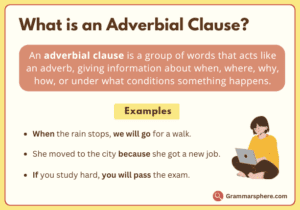
An adverbial clause is a group of words that explains how, when, where, or why something happens. It starts with a subordinating word and needs a main clause to complete its meaning.
Examples:
When the rain stops, we will go for a walk.
If you study hard, you will pass the exam.
You can call me whenever you need help.
How to Find an Adverb Clause in a Sentence
An adverb clause is a group of words that modifies the main verb, telling us how, when, where, why, or under what condition the action happens. To spot an adverb clause, look for a few key features:
1. Check for a Subject and Verb
Adverb clauses are complete groups of words that include both a subject and a verb.
2. Look for Subordinating Conjunctions
Adverb clauses often start with subordinating conjunctions like because, when, if, although, and since. These words connect the adverb clause to the main sentence.
3. Identify What the Clause Modifies
An adverb clause modifies the verb or action in the main sentence by adding details about how, when, where, or why. It answers one of these questions:
Adverbial Placement Rules
Adverbial placement refers to where adverbs should be placed within a sentence. Adverbs add detail to verbs, adjectives, or other adverbs, describing how, when, where, or how often an action happens. Following these simple rules will help you use adverbs correctly and make sentences clearer.
1. Adverbial Clause of Manner
These adverbs describe how an action happens. They usually come after the verb or at the end of a sentence.
- he speaks as if she knows everything.
- He laughed as though he had heard the funniest joke.
2. Adverbial Clause of Frequency
Adverbs like always, usually, often, sometimes, and never tell how often something happens. Place these adverbs before the main verb but after the verb “to be” (is, am, are, was, were).
- She arrives on time whenever she has a meeting.
- They are busy on weekends as often as their schedule allows.
3. Adverbial Clause of Time
These adverbs indicate when an action happens. They can be placed at the beginning or end of a sentence for emphasis.
- We will go when the weather gets better.
- I met an old friend after I finished work yesterday.
4. Adverbial Clause of Place
Adverbs like here, there, outside, inside describe where something occurs. They usually come after the main verb or at the end of a sentence.
- She waited where we had agreed to meet.
- They live where the river meets the sea.
5. Adverbial Clause of Degree
These adverbs show to what extent something is done, like very, quite, too, almost. They are placed before the word they modify.
- He is more talented than I expected.
- The meal was spicier than I could handle.
6. Adverbs Modifying Adjectives or Other Adverbs
When an adverb modifies an adjective or another adverb, place it right before the word it modifies.
- She is so generous that everyone admires her.
- The team played as well as they had practiced.

Examples of Adverbial Clauses
- She stayed home because she was feeling sick.
- If it rains tomorrow, we will cancel the picnic.
- He acts friendly even though he is shy.
- We will leave when the clock strikes midnight.
- As soon as he arrived, the meeting started.
- I’ll finish my work before the deadline approaches.
- Since you are here, let’s discuss the project.
- The dog barked until the cat ran away.
- Whenever she visits, she brings homemade cookies.
- He studied hard so that he could pass the exam.
- Though the weather was bad, they went hiking.
- We waited patiently while he finished his call.
- She jogs every morning as if it were a habit.
- I will call you once I reach home.
- They cheered loudly because their team won.
Adverbial Clauses vs. Adverbial Phrases
Adverbial clauses and adverbial phrases both add detail to a sentence by describing how, when, where, or why an action happens. However, they differ in structure and complexity.
1. Adverbial Clauses
An adverbial clause contains both a subject and a verb and relies on the main sentence to make sense. It usually starts with a subordinating conjunction like because, when, if, or although.
- When the rain started, we went inside.
- She stayed home because she was tired.
2. Adverbial Phrases
An adverbial phrase does not have a subject or a verb. It is a shorter group of words that gives simple, direct detail to the verb in the sentence.
- We went inside at sunset.
- She walked with confidence.
Adverb Clauses and Commas
Using commas with adverb clauses depends on where the clause appears in the sentence.
1. Adverb Clause at the Beginning of a Sentence
When an adverb clause comes at the start of a sentence, it should be followed by a comma. This comma separates the clause from the main part of the sentence.
- When the rain stopped, we went outside.
- If you finish your work, we can watch a movie.
2. Adverb Clause at the End of a Sentence
If the adverb clause is at the end of a sentence, a comma is usually not needed.
- We went outside when the rain stopped.
- We can watch a movie if you finish your work.
3. Exception: Emphasis or Clarity
A comma can be added before an adverb clause at the end of a sentence if it adds emphasis or makes the sentence clearer, but this is optional and not common.
Adverbial Clauses Are Dependent Clauses
An adverbial clause is a type of dependent clause. This means it cannot stand alone as a complete sentence because it depends on the main clause to make sense. Adverbial clauses add extra details to the main clause by telling us when, where, how, or why an action happens.
- When the storm ended, we went outside.
Here, when the storm ended is an adverbial clause that tells us when we went outside.
- She felt relieved because she passed the exam.
Because she passed the exam is an adverbial clause explaining why she felt relieved.
Common Mistakes with Adverbial Clause
Adverbial clauses add details about why, when, where, how, or under what condition something happens. Misplacing or using these clauses incorrectly can lead to confusion or awkward sentences. Below are common mistakes to watch for, with correct and incorrect examples to clarify.
- Missing Commas with Introductory Clauses
When an adverbial clause starts a sentence, a comma should follow it. Omitting this comma can confuse readers.
✗ If you finish your work we can go out.
✓ If you finish your work, we can go out.
- Using Adverbial Clauses Without a Clear Subject
Adverbial clauses must have a clear subject they refer to in the main clause. Without it, the sentence may not make sense.
✗ While watching the movie, the phone rang.
✓ While watching the movie, I heard the phone ring.
- Misplacing Adverbial Clauses
Adverbial clauses should be close to the main clause they modify; otherwise, they can confuse the meaning.
✗ She called her friend when she got home after a long day at work.
✓ She called her friend after she got home from a long day at work.
- Using Too Many Adverbial Clauses
Using too many adverbial clauses in one sentence can make it sound awkward and overwhelming.
✗ Because she was tired and because it was late, and because she didn’t feel like going out, she stayed home.
✓ Because she was tired and it was late, she stayed home.
- Inappropriate Use of Adverbial Clauses
Sometimes adverbial clauses don’t add meaningful information and should be simplified or removed.
✗ She studied hard because she wanted to pass the test, because she cared about her grades, because she didn’t want to fail.
✓ She studied hard because she wanted to pass the test.
FAQS:
What are adverbial clauses and examples?
Adverbial clauses are dependent clauses that function as adverbs, modifying a verb, adjective, or another adverb. They answer questions like when, where, why, how, and to what extent.
Examples:
She left because she was tired. (Answers “why”)
I will call you when I get home. (Answers “when”)
He ran as if his life depended on it. (Answers “how”)
What are examples of adverbial Clause?
Examples:
I stayed home because it was raining. (Reason)
She ran as if she were flying. (Manner)
We will leave when the sun sets. (Time)
Wherever you go, I will be there. (Place)
If you call me, I will answer. (Condition)
You May Also Like

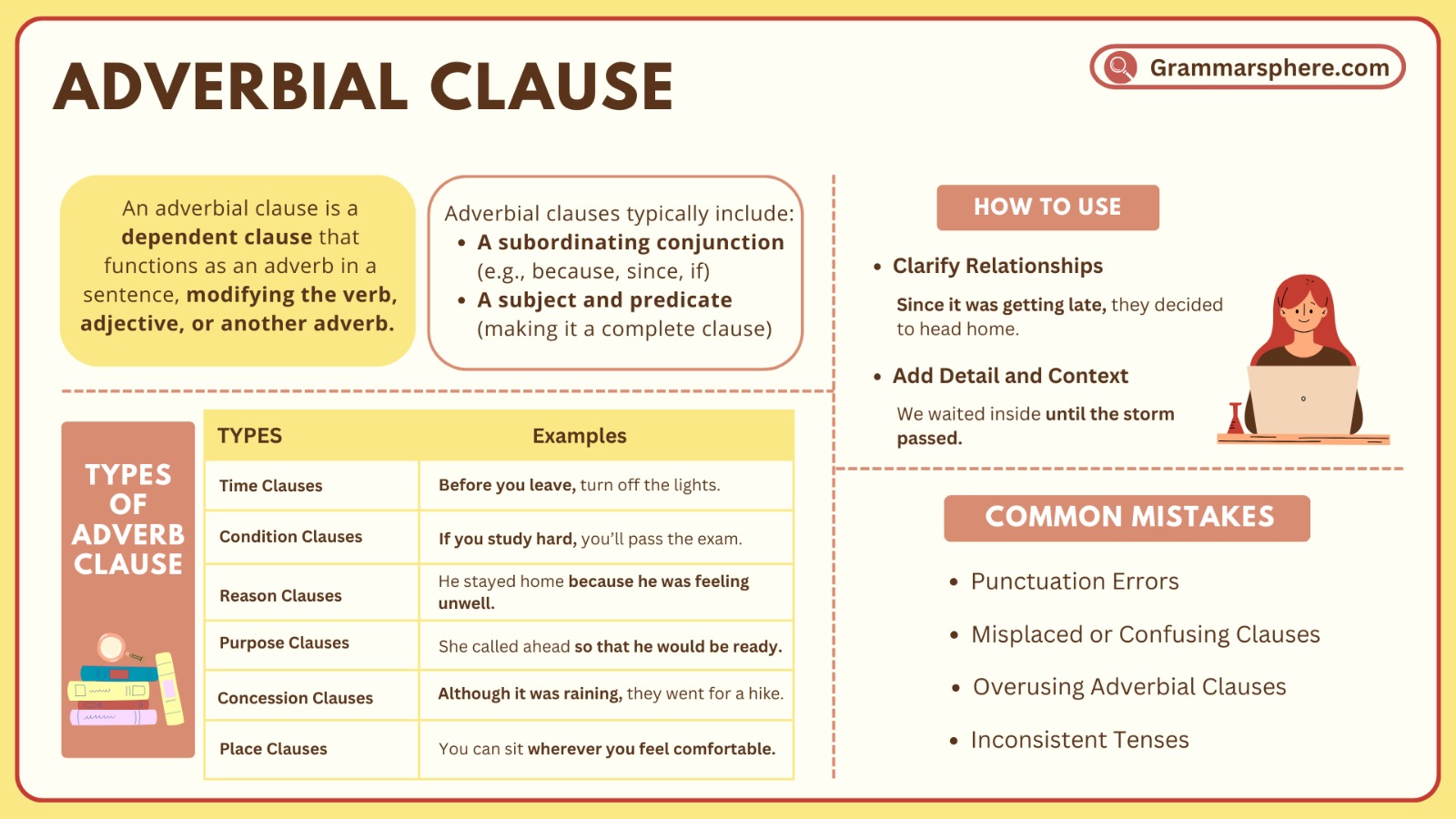
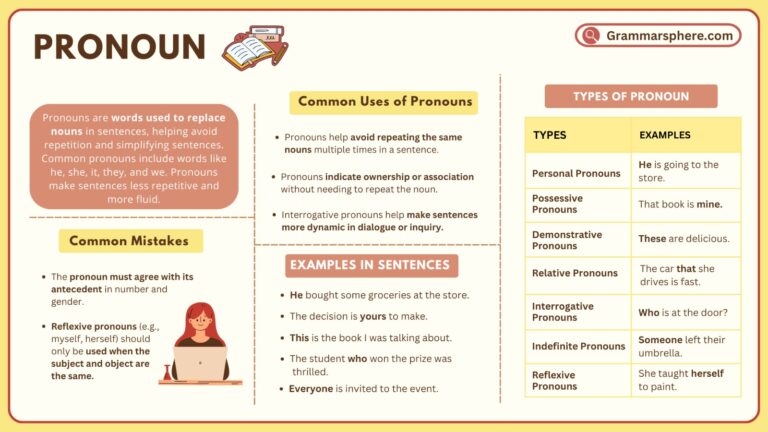
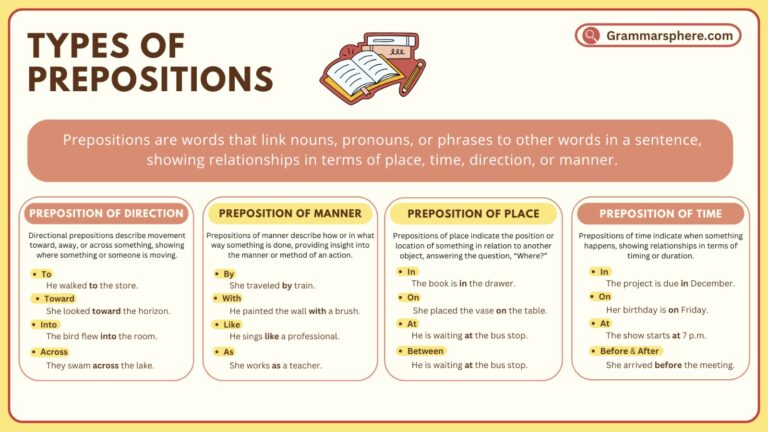


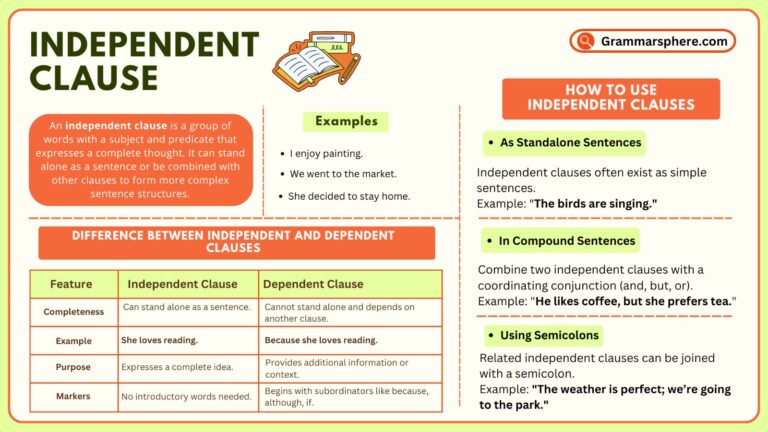
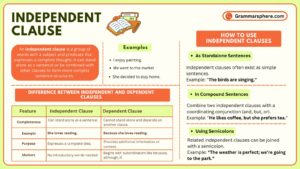

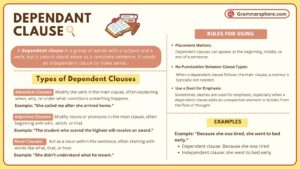
Leave a Comment